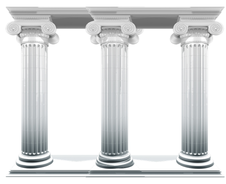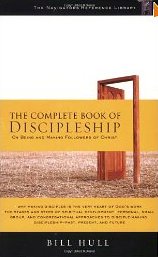The Starfish and the Spirit
by Lance Ford, Rob Wegner, and Alan Hirsch
I put Ori Brafman’s book, The Starfish and the Spider, in my favorites list, where this one will go, too. The concepts found in it are foundational and of great value to the church. In summary Brafman’s book describes the genius of decentralized organizations as opposed to hierarchical ones. A spider can be killed by squashing the head from which its life and government flows; but, if a starfish is cut into pieces, each piece will reproduce a entirely new starfish. That’s because it has no central brain. It’s neurological system is located throughout its body. The early church could not be stopped because it was decentralized like a starfish, relying on the Holy Spirit more than human leaders. The leaders could be killed, but the movement kept gaining momentum because its leadership came from Christ through the Spirit. You can read my more detailed summary by clicking here.
When I saw this book for sale, I had to buy it and was not disappointed. In some areas I feel Ford and Wegner became overly analytical, especially toward the end, but that may be because of how I am wired. Otherwise, the book stimulates thought and brought me back to many of the foundational concepts that were behind the founding of LifeNet, our small group based church. In this summary, I will highlight some of the quotes that mean the most to me, interspersing my own comments.
The authors came out of mega-church environments, where they were disappointed with some aspects of how such institutions are governed.
Many faith organizations, particularly those in North America, have unwittingly imported the human resources manuals of corporate America straight into their day-to-day workforce policy. We have let systems that make no claim whatsoever of being informed by the Word and Spirit of God set the rules for us. Earthly thinking never creates heavenly results. (Ford, Lance; Wegner, Rob; Hirsch, Alan. The Starfish and the Spirit (Exponential Series) (p. 106). Zondervan. Kindle Edition.)
They were looking for some way to bridge the gap between what they had been taught in their familiar church environment and the powerful disciple-making movements found in other parts of the world.
We live in an era of “missional movement” in terms of the global church. Currently, there are over 4,500 reports of active DMM/CPM engagement. Of those, 1,369 meet all four criteria! There are currently more than 76.9 million disciples in those 1,369 movements. From that total, 4.8 million churches have emerged, with an average size of 16.2 Microchurch is the “normal” church around the world. When you place that against the backdrop of “normal” in the New Testament, perhaps it’s time to consider the average church in the US as abnormal. These indigenous movements start with extraordinary prayer and fasting and focus on obedience-based discipleship, discovery forms of Bible engagement, and passionate and fearless sharing of the gospel. Authority is decentralized, so finding the “top leader” feels impossible, and the form of church is small, simple, and easy to produce. (Ford, Lance; Wegner, Rob; Hirsch, Alan. The Starfish and the Spirit (Exponential Series) (p. 66). Zondervan. Kindle Edition.)
We found a “Rosetta stone” that overlapped the language of institutional church and movemental church, deciphering for us our experience of church as movement in places outside the West, like India and China, showing us the way to speak that language and create that culture here in the West. That “Rosetta stone” was The Forgotten Ways by Alan Hirsch, which came out in 2006, the same year as The Starfish and the Spider. The combination of those books changed the trajectory of our lives. (Ford, Lance; Wegner, Rob; Hirsch, Alan. The Starfish and the Spirit (Exponential Series) (p. 6). Zondervan. Kindle Edition.)
This book combines principles from Brafman’s book and insights from Alan Hirsch with the authors’ own thoughts, experiences, and suggestions.
Again, our end goal is to see the church as movement reactivated, where all six of the mDNA elements can be cultivated and catalyzed. In The Permanent Revolution, Alan describes it this way: In short, apostolic [missional] movement involves a radical community of disciples, centered on the lordship of Jesus, empowered by the Spirit, built squarely on a fivefold ministry, organized around mission where everyone (not just professionals) is considered an empowered agent, and tends to be decentralized in organizational structure. . . . Apostolic movements require that we see church beyond its more institutional forms—as a movement of the whole people of God active in every sphere and domain of society. (Ford, Lance; Wegner, Rob; Hirsch, Alan. The Starfish and the Spirit (Exponential Series) (pp. 9-10). Zondervan. Kindle Edition.)
The above quote pretty much summarizes the book.
Alan Hirsch: The idea of organization has been described as “the mobilization of bias.”5 In other words, every organization is formed to achieve certain outcomes that can’t be achieved individually. It is important for leadership to take responsibility for the re-biasing of the organization or church to achieve the outcomes that Jesus intended for it. (Ford, Lance; Wegner, Rob; Hirsch, Alan. The Starfish and the Spirit (Exponential Series) (p. 10). Zondervan. Kindle Edition.)
When we restarted Liberty Church as LifeNet (Life Community Network), we worked to restructure the church around missional (disciple making) values instead of what has traditionally worked in the Western church. The church I love seeks to develop new people rather than showcase the most talented. It is no accident that Jesus chose very “ordinary” people to be the foundation of his worldwide apostolic movement. They became extraordinary when the Holy Spirit filled them and enabled them to follow Christ’s teachings and example.
The church literally exploded on to the scene on that first Pentecost after our Lord’s resurrection. It takes enormous trust in God to allow people to take initiative. The authors point out that what keeps things on track are common values, common mission, trust in God and one another, and great communication.
For those in teams, the most important thing to remember is this: you are in a peer relationship with those around you. This means each member commits to be willing to both give and receive feedback, critique, encouragement, and opinion in the spirit of generous discourse among team members. The commitment is to actively view one another as peer mentors and for each person to broaden their view of their own responsibilities. Everyone vows to keep eyes, ears, and minds open to issues, opportunities, threats, and solutions. When people work together with freedom as an overarching premise, they are motivated not by a single charismatic leader but by the shared vision and goals that come from the mission itself. In a setting such as this, team members are peers, working together as such and holding one another accountable for the overall performance and results of the group as a whole. (Ford, Lance; Wegner, Rob; Hirsch, Alan. The Starfish and the Spirit (Exponential Series) (p. 133). Zondervan. Kindle Edition.)
In the starfish expression, we see that every member contains within them a church, and every church contains within it a movement. Here in the West, we have a hard time conceiving of this possibility of power being so decentralized. Yet outside the Western world, this view is quite normal. The starfish is best represented by the viral spread of the underground organic church movements in China, India, and many other places around the world. (Ford, Lance; Wegner, Rob; Hirsch, Alan. The Starfish and the Spirit (Exponential Series) (p. 20). Zondervan. Kindle Edition.)
Small groups generally are the building blocks of organic church movements.
Imagine the church as a decentralized network of multiplying disciples, missional leaders, and microchurches, the smallest and most essential expression of church. Unlike a denomination or association of churches, which confers ordination and provides general accountability to church leaders through centralized structure, a starfish movement is apostolic—organized around mission breaking through in new contexts—and organizes as a network of networks, made up of families of churches with a common focus, minus the restrictive structures of a denomination.5 (Ford, Lance; Wegner, Rob; Hirsch, Alan. The Starfish and the Spirit (Exponential Series) (p. 19). Zondervan. Kindle Edition.)
Martin Luther championed the idea of the priesthood of the believer, meaning that the New Testament church does not rely upon a professional clergy to mediate between God and the ordinary people. Jesus through the Holy Spirit makes every disciple a minister.
In the Harvard Business Review article “Understanding ‘New Power’,” authors Jeremy Heimans and Henry Timms make the following distinction between “old power,” what we call the spider, and “new power,” what we call starfish: Old power works like a currency. It is held by few. Once gained, it is jealously guarded, and the powerful have a substantial store of it to spend. It is closed, inaccessible, and leader-driven. It downloads, and it captures. New power operates differently, like a current. It is made by many. It is open, participatory, and peer-driven. It uploads, and it distributes. Like water or electricity, it’s most forceful when it surges. The goal with new power is not to hoard it but to channel it.12
Alan Hirsch: In every group of people—and this is particularly true of God’s people, the body of Christ—intelligence is not focused in one or two people but is laced throughout the organization (e.g., 1 Cor. 12:12–27; Eph. 4:1–16). Every part has a role to play in the success and maturity of the whole. This is called distributed intelligence. I invite you to compare your church with that of the New Testament, and be willing to rethink your own structures in the light of Jesus’ original design. New power gains influence from growing other’s capacity and increasing their influence to move beyond consumption and join in as cocreators. God’s design for the Body is clearly one of new power: From whom the whole body, joined and held together by every joint with which it is equipped, when each part is working properly, makes the body grow so that it builds itself up in love. (Eph. 4:16 ESV) (Ford, Lance; Wegner, Rob; Hirsch, Alan. The Starfish and the Spirit (Exponential Series) (pp. 23-24). Zondervan. Kindle Edition.)
Could it be that the reason that many leaders unconsciously seek to supplant Jesus’ role as leader of the church is because of a lack of faith in the Spirit’s capacity to administrate the church? Giving ordinary people permission to minister and take initiative can feel as if we are losing control. Exactly!
We aren’t designed for old power, which is built on institutional hierarchy, but new power, which flows and feels like organic systems: a body, yeast, seeds, trees, living temples, and vines. Let’s consider again the old power models. Heimans and Timms describe it this way: Old power models tend to require little more than consumption. . . . But new power taps into people’s growing capacity—and desire—to participate in ways that go beyond consumption. (Ford, Lance; Wegner, Rob; Hirsch, Alan. The Starfish and the Spirit (Exponential Series) (p. 25). Zondervan. Kindle Edition.)
The focus shifts from developing your own leadership to multiplying and developing the influence of others, decentralizing the power and authority out to them while activating their gifts, their dreams, and their kingdom assignments. (Ford, Lance; Wegner, Rob; Hirsch, Alan. The Starfish and the Spirit (Exponential Series) (p. 28). Zondervan. Kindle Edition.)
Coaches don’t want to be the hero, but bosses often do. Coaches find their joy in making heroes of others. By the time they return to Antioch, Paul and Barnabas are peers. When we allow our organizations to be ruled on the Spirit’s shoulders, governance happens regularly, distributed throughout the organization. No longer does it rest on one single leader but becomes a key process shared by many. It changes the way we function in leadership by changing the way we view our roles. Distributed leadership means that “functions that traditionally reside with a CEO or executive team (move) into processes that are enacted throughout the organization, (Ford, Lance; Wegner, Rob; Hirsch, Alan. The Starfish and the Spirit (Exponential Series) (p. 116). Zondervan. Kindle Edition.)
Family and freedom are as important as anything for those who hope to perpetuate movemental endeavors. Leaders who trust their teams like family show the greatest trust in God because God is in the people that make up those teams. Developing cultures of freedom is the proof of trust and belief in the Spirit of God to do his work through his people. Any team member should be able to talk to anyone about anything relating to the organization and its endeavors. Freedom in our workplaces is the most natural and efficient way to operate. God has even designed our neurology so freedom within the safety of family environment is sought and rewarded. (Ford, Lance; Wegner, Rob; Hirsch, Alan. The Starfish and the Spirit (Exponential Series) (p. 112). Zondervan. Kindle Edition.)
Just as there is the full potential of a forest in every seed, so too is the task of leadership to help every disciple to be a movement in the making.17 (Ford, Lance; Wegner, Rob; Hirsch, Alan. The Starfish and the Spirit (Exponential Series) (p. 27). Zondervan. Kindle Edition.)
When we launched LifeNet, our goal was to simplify church so that our members could devote more time with their friends and neighbors in the hope of influencing them toward the kingdom of God.
The gospel presence of an extended spiritual family on mission is, in the authors’ opinion, the most compelling witness to be offered to our current culture. (Ford, Lance; Wegner, Rob; Hirsch, Alan. The Starfish and the Spirit (Exponential Series) (p. 202). Zondervan. Kindle Edition.)
The idea is that we are to be salt and life wherever we are and in whatever roles we have in society. God wants the church to impact the world.
Alan Hirsch: The true following of Jesus (discipleship) requires some form of profound conversion, one that implies engagement of our whole being with the whole of reality, with God at its center. More specifically, conversion requires that we give the whole of ourselves irrevocably to the whole of God in a way that involves the whole of creation. Everything changes! (Ford, Lance; Wegner, Rob; Hirsch, Alan. The Starfish and the Spirit (Exponential Series) (p. 172). Zondervan. Kindle Edition.)
That’s the end game of the movement starfish: to fill everything every way with the fullness of Jesus. The movement starfish is designed to embody, in a practical and measurable way, the end we are seeking—a missional movement. (Ford, Lance; Wegner, Rob; Hirsch, Alan. The Starfish and the Spirit (Exponential Series) (p. 37). Zondervan. Kindle Edition.)
The book devotes a lot of pages to discussing how to multiply through disciple making, which is the main mission of the church, according to the Great Commission.
Outside of mission, disciples harden and become souvenirs sitting in services and small groups, at best dim reminders of what they were meant to be—agents of mission and healing. (Ford, Lance; Wegner, Rob; Hirsch, Alan. The Starfish and the Spirit (Exponential Series) (p. 208). Zondervan. Kindle Edition.)
Furthermore, mission is not something outside of God. Mission is woven into his very nature. Mission is the heartbeat of God. This is the reason God left his throne on mission. (Ford, Lance; Wegner, Rob; Hirsch, Alan. The Starfish and the Spirit (Exponential Series) (p. 209). Zondervan. Kindle Edition.)
Mission is not meant to be a category of activity that we try to fit into the discretional time slot in our lives as a “volunteer” who serves on the weekends or a “member who brings a friend to church.” It is all of life. When volunteering or bringing a friend to a weekend service is the overflow of a mission-fixated, incarnational lifestyle, it’s beautiful. When it is a substitute, we’ve settled for a domesticated version of Christianity that will never change the world. (Ford, Lance; Wegner, Rob; Hirsch, Alan. The Starfish and the Spirit (Exponential Series) (p. 211). Zondervan. Kindle Edition.)
Therefore, the degree to which they are fixated on mission is the degree to which effective disciple-making happens. It is a necessary ingredient for intentional disciple-making. (Ford, Lance; Wegner, Rob; Hirsch, Alan. The Starfish and the Spirit (Exponential Series) (p. 209). Zondervan. Kindle Edition.)
When we launched LifeNet, our goal was to become more effective at making disciples instead of mere church goers. We have not yet succeeded, but we are still moving in that direction. Disciple making requires instruction, modeling, and participation in the ministry, not simply listening to a talking head download information to us.
In the Western religious experience, content and doctrine are king. Much of what is labeled “discipleship,” “confirmation,” or “training” in the church is just a data dump. We are content focused, fueled, and fixated. The emphasis is on transferring content, with little concern for whether people are actually transformed or multiplying. Content-codependence is the diagnosis. Our addiction to “content” enables immaturity and underachievement in disciple-making. (Ford, Lance; Wegner, Rob; Hirsch, Alan. The Starfish and the Spirit (Exponential Series) (p. 215). Zondervan. Kindle Edition.)
The church that aims at mission will have to do ministry, because ministry is the means to mission. (Ford, Lance; Wegner, Rob; Hirsch, Alan. The Starfish and the Spirit (Exponential Series) (p. 208). Zondervan. Kindle Edition.)
Clearly making disciples is the greatest challenge we face as the church.
Discipling—which involves coaching and mentoring—is never simply a transactional program; it includes an offer of some level of life together. (Ford, Lance; Wegner, Rob; Hirsch, Alan. The Starfish and the Spirit (Exponential Series) (p. 114). Zondervan. Kindle Edition.)
The authors believe that imparting a missional core to small groups so that their central purpose is to multiply is essential.
The microchurches set entire oikos ablaze with the grace of God, like wildfire igniting an entire relational network with the gospel. By now you might be sensing how different this is from what most churches call small groups. Unlike traditional small groups, microchurches are a pure missionary endeavor, where the gospel is planted into a network or neighborhood and disciples emerge and form a new community. These groups are proximate and incarnational in that neighborhood or network, unlike traditional small groups in which professionals usually organize people from many networks and neighborhoods into groups. Because microchurches are embedded into a particular neighborhood or network of relationships, daily discipleship and gospel community become the norm. This is vastly different from most small groups, which are typically formed for assimilation and content delivery to churchgoers. (Ford, Lance; Wegner, Rob; Hirsch, Alan. The Starfish and the Spirit (Exponential Series) (p. 46). Zondervan. Kindle Edition.)
Imagine if every street had at least two people who said, “I will bless the people on this street! I will begin in prayer for each neighbor. I will listen deeply to the story of my neighbors and my neighborhood. I will eat with them. I will serve them. I will share the good news.” As the gospel is planted in that context, Jesus draws people to himself, disciples are multiplied, and a house—a new expression of the church—emerges. (Ford, Lance; Wegner, Rob; Hirsch, Alan. The Starfish and the Spirit (Exponential Series) (p. 49). Zondervan. Kindle Edition.)
Multiplying Disciples Disciple: a person who hears and obeys Jesus. The movement starfish begins with developing disciples, people who hear and obey Jesus in all of life. Then those disciples make other disciples. The critical starting point of any faith movement is the flourishing and multiplying that happens when individuals become owners of the faith. (Ford, Lance; Wegner, Rob; Hirsch, Alan. The Starfish and the Spirit (Exponential Series) (p. 50). Zondervan. Kindle Edition.)
As we look at the inspiring stories of phenomenal apostolic movements in history, all are first and foremost disciple-making systems. On this, Alan remarks, “The rather funny thing is that they never appear to get beyond this—they never move beyond mere disciple making. (Ford, Lance; Wegner, Rob; Hirsch, Alan. The Starfish and the Spirit (Exponential Series) (p. 154). Zondervan. Kindle Edition.)
Disciple-making isn’t about being the expert. It’s about learning and adding back in the basic key ingredients any cook can find, which the people of God have known and practiced for centuries. It doesn’t require an advanced degree, a lot of complex preparation, or complicated skills. (Ford, Lance; Wegner, Rob; Hirsch, Alan. The Starfish and the Spirit (Exponential Series) (pp. 167-168). Zondervan. Kindle Edition.)
Multiplying Leaders Leader: a disciple who has made disciples. As people begin to multiply disciples, they become leaders, often without knowing it. As each disciple becomes one who makes one, who can make another, then all followers are invited to be leaders. (Ford, Lance; Wegner, Rob; Hirsch, Alan. The Starfish and the Spirit (Exponential Series) (pp. 50-51). Zondervan. Kindle Edition.)
Multiplying Houses (Microchurches) House: an extended spiritual family, led by ordinary people, who live in everyday gospel community and own the mission of Jesus in a network of relationships. Also known as a microchurch. Some call these missional communities or organic churches. As we multiply missional teams and microchurches, we start filling neighborhoods and networks. These usually range from ten to fifty people who can meet in homes or second and third spaces while living in daily gospel community. (Ford, Lance; Wegner, Rob; Hirsch, Alan. The Starfish and the Spirit (Exponential Series) (p. 51). Zondervan. Kindle Edition.)
Multiplying Hubs Hub: an apostolic team using a shared space to fuel and equip a network of disciples, leaders, and microchurches in a city or region. (Ford, Lance; Wegner, Rob; Hirsch, Alan. The Starfish and the Spirit (Exponential Series) (p. 52). Zondervan. Kindle Edition.)
Multiplying Networks Network: two or more hubs/churches intentionally and collaboratively working together in a city or region around a shared kingdom mission. In the New Testament, we witness the power of networks. A microchurch is a network of disciples that make up a new spiritual family on mission. The church in a city—like Jerusalem, Rome, Corinth, or Ephesus—is a network of microchurches. The churches/hubs in a city network work together with other churches/hubs in other cities, forming a regional network. (Ford, Lance; Wegner, Rob; Hirsch, Alan. The Starfish and the Spirit (Exponential Series) (pp. 54-55). Zondervan. Kindle Edition.)
From this point on, the authors devote almost three-fourths of the book to measuring movements and developing strategies for multiplying disciples and leaders. Below are some notable quotes.
Rank-based concepts create a hierarchy. At the top are leaders, a select and privileged few. Below them are followers, the vast majority.6 This type of thinking quashes the collective intelligence of an organization. It shuts down creativity, heart, and drive under the mindset that only a small group of “gifted” ones contain the competence for decision-making. Sadly, leadership like this slams the door on the unlimited potential of most of our team members. Even more tragic is that the gifts God wants to give our organizations via the silenced majority are summarily rejected by the upper echelon. When this happens, we aren’t playing with the full deck God has dealt us. (Ford, Lance; Wegner, Rob; Hirsch, Alan. The Starfish and the Spirit (Exponential Series) (p. 88). Zondervan. Kindle Edition.)
Jesus alone can bear the weight of headship. Yet many, if not most, churches see the lead pastor or a handful of leaders as the “head in residence” in lieu of Jesus. This happens subtly and subversively, not so much intentionally, because church leaders have inherited a centuries-old social contract that must be actively deconstructed in order for Jesus’ rightful headship to become apparent to all. Whereas this model of false headship is characterized by a crushing weight and level of difficulty that is hard beyond bearing, the headship of Jesus offers us a refreshing and radical alternative. Come to me, all you who are weary and burdened, and I will give you rest. Take my yoke upon you and learn from me, for I am gentle and humble in heart, and you will find rest for your souls. For my yoke is easy and my burden is light. (Matt. 11:28–30) (Ford, Lance; Wegner, Rob; Hirsch, Alan. The Starfish and the Spirit (Exponential Series) (pp. 94-95). Zondervan. Kindle Edition.)
When we view church and faith-based organizations as typical businesses, we end up viewing those who should be our yokefellows and peers as employees and subordinates. As we will show later, this is not to say everyone has the same role or ability. Different giftings and talents equip us all for different roles. What causes us to go off the rails—through the sin of lording over others—is the tendency to rank the rarer gifts and talents of a few servants above the more common gifts and talents held by others. (Ford, Lance; Wegner, Rob; Hirsch, Alan. The Starfish and the Spirit (Exponential Series) (p. 98). Zondervan. Kindle Edition.)
The starfish goal is not to give everyone the exact same volume of power. The quest is to make everyone as powerful as possible. This means we let go of the overwrought identity of leader and embrace the roll of a catalyst. The catalyst shapes culture and DNA but is happy to cede control in the moment to the members of the team. In letting go of the headship role, the catalyst transfers deep, shared ownership and responsibility to the circle under the leadership of the Spirit of God. The results are freedom for creativity, greater buy-in, lasting stability, mutual respect, and deeper community. (Ford, Lance; Wegner, Rob; Hirsch, Alan. The Starfish and the Spirit (Exponential Series) (pp. 123-124). Zondervan. Kindle Edition.)
Making the titular shift from senior leader to coworker is not a negative change in status unless the leader feels the need to leverage his or her title or seniority. The starfish effect is not a demotion of any one leader. It is a promotion for everyone! It unleashes the servantship spirit throughout the organization. (Ford, Lance; Wegner, Rob; Hirsch, Alan. The Starfish and the Spirit (Exponential Series) (p. 124). Zondervan. Kindle Edition.)
Starfish thinking “does not mean that we are all interchangeable, or that we are all the same—with equal talents, experience, needs, ambitions, and so forth—or that we even make equal contributions. But what it does assert is that all members of the organization have equal standing.”11 This paradigm is rooted in the belief that the answers to our problems or opportunities are not relegated to top-tier leadership but can be found at any place within the circle. (Ford, Lance; Wegner, Rob; Hirsch, Alan. The Starfish and the Spirit (Exponential Series) (p. 126). Zondervan. Kindle Edition.)
Self-management, and the green pastures of freedom it brings, is an appealing proposition. But higher degrees of freedom last only with greater degrees of responsibility. Entering these meadowlands means we can no longer hide in the barns of blaming bosses for our own mistakes, laziness, or indifference. To be treated like an adult requires acting like one. (Ford, Lance; Wegner, Rob; Hirsch, Alan. The Starfish and the Spirit (Exponential Series) (p. 145). Zondervan. Kindle Edition.)
I hope you will take time to read this book. I highlighted some of the more meaningful passages from my perspective. Perhaps you will gain other insights because of your unique perspective, gifting, and calling.




